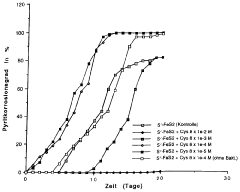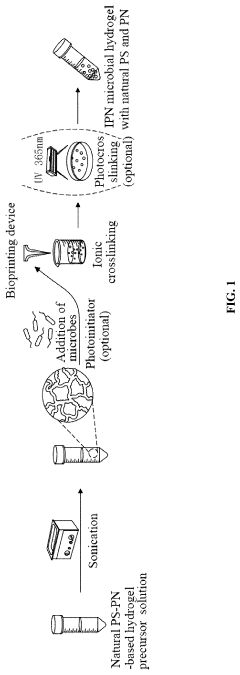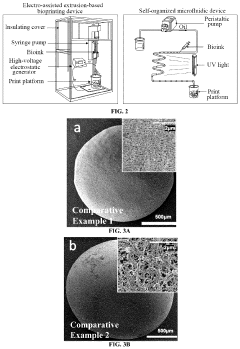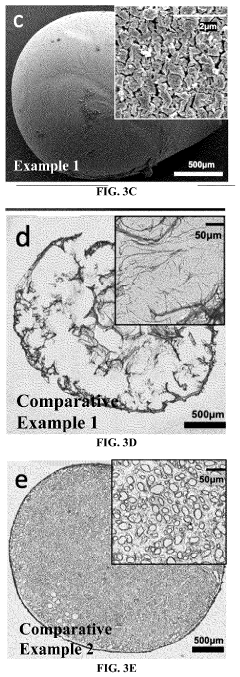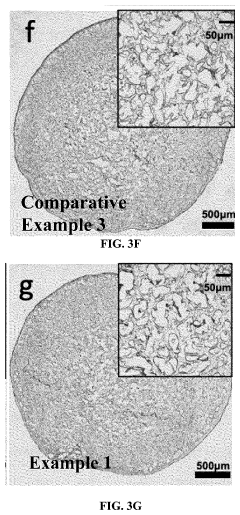Lepidolite's contribution to microbial interactions in mining environments
AUG 19, 20259 MIN READ
Generate Your Research Report Instantly with AI Agent
Patsnap Eureka helps you evaluate technical feasibility & market potential.
Lepidolite Mining Context
Lepidolite mining has gained significant attention in recent years due to its importance as a lithium-bearing mineral. The context of lepidolite mining is closely tied to the growing demand for lithium in various industries, particularly in the production of rechargeable batteries for electric vehicles and portable electronics. This surge in demand has led to increased exploration and extraction activities in lepidolite-rich areas worldwide.
Lepidolite is typically found in pegmatite deposits, which are coarse-grained igneous rocks formed from the crystallization of magma. These deposits are often associated with granitic intrusions and can be found in various geological settings. The mining of lepidolite involves both surface and underground extraction methods, depending on the depth and accessibility of the deposits.
The extraction process for lepidolite is complex and requires careful consideration of environmental factors. Traditional mining methods often involve open-pit mining, followed by crushing, grinding, and flotation to separate lepidolite from other minerals. However, these processes can have significant environmental impacts, including habitat disruption, water pollution, and the generation of tailings.
In recent years, there has been a growing focus on developing more sustainable and environmentally friendly mining practices for lepidolite extraction. This includes the exploration of in-situ leaching techniques, which involve injecting a leaching solution directly into the ore body to dissolve and extract the desired minerals. Such methods aim to minimize surface disturbance and reduce water consumption.
The microbial interactions in lepidolite mining environments play a crucial role in both the extraction process and the environmental impact of mining activities. Microorganisms present in these environments can influence the solubility and mobility of lithium and other elements, potentially affecting the efficiency of extraction processes. Additionally, certain microbes may contribute to the natural attenuation of mining-related contaminants, offering potential for bioremediation strategies.
Understanding the microbial ecology of lepidolite mining sites is essential for developing sustainable mining practices and mitigating environmental impacts. Research in this area focuses on identifying and characterizing the microbial communities present in these environments, as well as their interactions with lepidolite and other minerals. This knowledge can inform the development of bio-based extraction methods and contribute to more effective site remediation strategies.
The global distribution of lepidolite deposits adds another layer of complexity to the mining context. Significant deposits are found in countries such as Portugal, Brazil, Australia, and Zimbabwe, among others. This geographical diversity influences the economic and geopolitical aspects of lepidolite mining, as well as the specific environmental and regulatory challenges faced in different regions.
Lepidolite is typically found in pegmatite deposits, which are coarse-grained igneous rocks formed from the crystallization of magma. These deposits are often associated with granitic intrusions and can be found in various geological settings. The mining of lepidolite involves both surface and underground extraction methods, depending on the depth and accessibility of the deposits.
The extraction process for lepidolite is complex and requires careful consideration of environmental factors. Traditional mining methods often involve open-pit mining, followed by crushing, grinding, and flotation to separate lepidolite from other minerals. However, these processes can have significant environmental impacts, including habitat disruption, water pollution, and the generation of tailings.
In recent years, there has been a growing focus on developing more sustainable and environmentally friendly mining practices for lepidolite extraction. This includes the exploration of in-situ leaching techniques, which involve injecting a leaching solution directly into the ore body to dissolve and extract the desired minerals. Such methods aim to minimize surface disturbance and reduce water consumption.
The microbial interactions in lepidolite mining environments play a crucial role in both the extraction process and the environmental impact of mining activities. Microorganisms present in these environments can influence the solubility and mobility of lithium and other elements, potentially affecting the efficiency of extraction processes. Additionally, certain microbes may contribute to the natural attenuation of mining-related contaminants, offering potential for bioremediation strategies.
Understanding the microbial ecology of lepidolite mining sites is essential for developing sustainable mining practices and mitigating environmental impacts. Research in this area focuses on identifying and characterizing the microbial communities present in these environments, as well as their interactions with lepidolite and other minerals. This knowledge can inform the development of bio-based extraction methods and contribute to more effective site remediation strategies.
The global distribution of lepidolite deposits adds another layer of complexity to the mining context. Significant deposits are found in countries such as Portugal, Brazil, Australia, and Zimbabwe, among others. This geographical diversity influences the economic and geopolitical aspects of lepidolite mining, as well as the specific environmental and regulatory challenges faced in different regions.
Microbial Ecology Market
The microbial ecology market related to lepidolite mining environments is experiencing significant growth due to increasing awareness of the role microorganisms play in mineral extraction processes. This market segment encompasses various products and services aimed at understanding, manipulating, and optimizing microbial communities in mining operations, particularly those involving lepidolite extraction.
The demand for microbial ecology solutions in lepidolite mining is driven by several factors. Firstly, the growing emphasis on sustainable and environmentally friendly mining practices has led to increased interest in bioleaching and other microbial-based extraction methods. These approaches can potentially reduce the environmental impact of traditional mining techniques while improving efficiency.
Secondly, the rising global demand for lithium, a key component of lepidolite, has spurred investment in innovative extraction technologies. Microbial ecology solutions offer the potential to enhance lithium recovery rates and reduce processing costs, making them attractive to mining companies seeking to optimize their operations.
The market for microbial ecology products and services in lepidolite mining environments can be broadly categorized into three main segments: microbial community analysis, bioleaching solutions, and environmental monitoring tools. Microbial community analysis services involve the identification and characterization of microbial populations present in mining sites, providing valuable insights for process optimization. Bioleaching solutions encompass the development and application of specialized microbial consortia to enhance mineral extraction. Environmental monitoring tools focus on assessing the impact of mining activities on local ecosystems and ensuring compliance with regulatory standards.
Key players in this market include biotechnology companies specializing in environmental microbiology, mining technology providers, and research institutions. These entities are actively developing new technologies and methodologies to harness the power of microorganisms in lepidolite mining processes.
The market potential for microbial ecology solutions in lepidolite mining is substantial, with projections indicating steady growth over the coming years. This growth is expected to be driven by the increasing adoption of bio-based extraction methods, stricter environmental regulations, and the ongoing quest for more efficient and cost-effective mining practices.
The demand for microbial ecology solutions in lepidolite mining is driven by several factors. Firstly, the growing emphasis on sustainable and environmentally friendly mining practices has led to increased interest in bioleaching and other microbial-based extraction methods. These approaches can potentially reduce the environmental impact of traditional mining techniques while improving efficiency.
Secondly, the rising global demand for lithium, a key component of lepidolite, has spurred investment in innovative extraction technologies. Microbial ecology solutions offer the potential to enhance lithium recovery rates and reduce processing costs, making them attractive to mining companies seeking to optimize their operations.
The market for microbial ecology products and services in lepidolite mining environments can be broadly categorized into three main segments: microbial community analysis, bioleaching solutions, and environmental monitoring tools. Microbial community analysis services involve the identification and characterization of microbial populations present in mining sites, providing valuable insights for process optimization. Bioleaching solutions encompass the development and application of specialized microbial consortia to enhance mineral extraction. Environmental monitoring tools focus on assessing the impact of mining activities on local ecosystems and ensuring compliance with regulatory standards.
Key players in this market include biotechnology companies specializing in environmental microbiology, mining technology providers, and research institutions. These entities are actively developing new technologies and methodologies to harness the power of microorganisms in lepidolite mining processes.
The market potential for microbial ecology solutions in lepidolite mining is substantial, with projections indicating steady growth over the coming years. This growth is expected to be driven by the increasing adoption of bio-based extraction methods, stricter environmental regulations, and the ongoing quest for more efficient and cost-effective mining practices.
Lepidolite-Microbe Challenges
The integration of lepidolite into mining environments presents several significant challenges in terms of microbial interactions. One of the primary concerns is the potential disruption of existing microbial ecosystems within the mining sites. Lepidolite, being a lithium-rich mineral, can introduce high concentrations of lithium ions into the environment, which may alter the pH and chemical composition of the surrounding soil and water.
These changes can have profound effects on the native microbial communities, potentially leading to shifts in species composition and abundance. Some microorganisms may struggle to adapt to the increased lithium levels, while others might thrive, creating imbalances in the ecosystem. This alteration of microbial populations could have cascading effects on biogeochemical cycles and nutrient availability in the mining area.
Another challenge lies in the potential for lepidolite to interact with microorganisms involved in bioleaching processes. While some bacteria are known to facilitate the extraction of metals from ores, the presence of lepidolite may inhibit or alter their activities. The high lithium content could potentially interfere with the metabolic pathways of these microorganisms, reducing their efficiency in metal extraction or even rendering them inactive.
Furthermore, the introduction of lepidolite may lead to the formation of new microbial consortia adapted to high-lithium environments. These novel microbial communities could potentially develop unique metabolic capabilities, which may have both positive and negative implications for mining operations. On one hand, they might aid in the extraction of lithium from lepidolite, but on the other, they could contribute to unforeseen biogeochemical processes that complicate mining activities.
The presence of lepidolite also raises concerns about the potential for increased microbial resistance to heavy metals and other toxic compounds commonly found in mining environments. Microorganisms exposed to high levels of lithium may develop mechanisms to cope with metal stress, potentially leading to the emergence of multi-metal resistant strains. This could have implications for bioremediation efforts and the long-term management of mining sites.
Lastly, the interaction between lepidolite and microbes may influence the mobility and bioavailability of other elements present in the mining environment. Microbial activities can alter the speciation of metals, potentially increasing or decreasing their solubility and transport in soil and water. The presence of lepidolite could modify these processes, leading to unexpected changes in the distribution and accessibility of various elements, which may impact both mining efficiency and environmental management strategies.
These changes can have profound effects on the native microbial communities, potentially leading to shifts in species composition and abundance. Some microorganisms may struggle to adapt to the increased lithium levels, while others might thrive, creating imbalances in the ecosystem. This alteration of microbial populations could have cascading effects on biogeochemical cycles and nutrient availability in the mining area.
Another challenge lies in the potential for lepidolite to interact with microorganisms involved in bioleaching processes. While some bacteria are known to facilitate the extraction of metals from ores, the presence of lepidolite may inhibit or alter their activities. The high lithium content could potentially interfere with the metabolic pathways of these microorganisms, reducing their efficiency in metal extraction or even rendering them inactive.
Furthermore, the introduction of lepidolite may lead to the formation of new microbial consortia adapted to high-lithium environments. These novel microbial communities could potentially develop unique metabolic capabilities, which may have both positive and negative implications for mining operations. On one hand, they might aid in the extraction of lithium from lepidolite, but on the other, they could contribute to unforeseen biogeochemical processes that complicate mining activities.
The presence of lepidolite also raises concerns about the potential for increased microbial resistance to heavy metals and other toxic compounds commonly found in mining environments. Microorganisms exposed to high levels of lithium may develop mechanisms to cope with metal stress, potentially leading to the emergence of multi-metal resistant strains. This could have implications for bioremediation efforts and the long-term management of mining sites.
Lastly, the interaction between lepidolite and microbes may influence the mobility and bioavailability of other elements present in the mining environment. Microbial activities can alter the speciation of metals, potentially increasing or decreasing their solubility and transport in soil and water. The presence of lepidolite could modify these processes, leading to unexpected changes in the distribution and accessibility of various elements, which may impact both mining efficiency and environmental management strategies.
Current Bioleaching Methods
01 Microbial interactions with lepidolite in lithium extraction
Certain microorganisms can interact with lepidolite to facilitate lithium extraction. These microbes may enhance the dissolution of lepidolite or selectively accumulate lithium, potentially improving the efficiency of lithium recovery processes from this mineral source.- Microbial interactions with lepidolite in lithium extraction: Certain microorganisms can interact with lepidolite to facilitate lithium extraction. These microbes may enhance the dissolution of lepidolite or selectively accumulate lithium, potentially improving the efficiency of lithium recovery processes from this mineral source.
- Bioleaching processes involving lepidolite: Bioleaching techniques can be applied to lepidolite for metal extraction. Specific microorganisms may be used to solubilize lithium and other valuable elements from lepidolite through their metabolic activities, offering an environmentally friendly alternative to traditional chemical leaching methods.
- Microbial community dynamics in lepidolite-rich environments: The presence of lepidolite in soil or water environments can influence microbial community structures. Studies on these interactions may reveal unique microbial adaptations to lepidolite-rich habitats and potential applications in biotechnology or environmental remediation.
- Biofilm formation on lepidolite surfaces: Microorganisms may form biofilms on lepidolite surfaces, potentially altering the mineral's properties or facilitating its weathering. Understanding these biofilm-mineral interactions could lead to novel applications in mineral processing or environmental sciences.
- Microbial-induced lepidolite transformation: Certain microbes may induce chemical or physical transformations in lepidolite through their metabolic activities. These transformations could alter the mineral's properties, potentially creating new materials or improving existing processes in industries such as ceramics or electronics.
02 Bioleaching processes involving lepidolite
Bioleaching techniques can be applied to lepidolite for metal extraction. Specific microorganisms may be used to solubilize or concentrate metals from lepidolite through their metabolic activities, offering an environmentally friendly alternative to traditional chemical leaching methods.Expand Specific Solutions03 Microbial community dynamics in lepidolite-rich environments
The presence of lepidolite in soil or water environments can influence microbial community structures. Studies on these interactions can provide insights into microbial ecology in mineral-rich habitats and potential applications in bioremediation or biomining.Expand Specific Solutions04 Biofilm formation on lepidolite surfaces
Microorganisms may form biofilms on lepidolite surfaces, which can affect the mineral's properties and its interactions with the environment. Understanding these biofilm formations can be crucial for developing strategies in mineral processing or environmental management.Expand Specific Solutions05 Microbial-induced weathering of lepidolite
Microbial activities can contribute to the weathering of lepidolite in natural environments. This process may involve the production of organic acids or other metabolites by microorganisms, which can accelerate the breakdown of the mineral and release its constituent elements.Expand Specific Solutions
Key Mining Biotech Players
The field of lepidolite's contribution to microbial interactions in mining environments is in its early developmental stages, with a growing market driven by increasing demand for sustainable mining practices. The technology's maturity is still evolving, with research institutions like Chengdu University of Technology, Indian Institutes of Technology, and Central South University leading academic efforts. Companies such as BiotaTec OUE and Wanbao Mining Ltd. are exploring commercial applications, while government bodies like CSIR are supporting research initiatives. The competitive landscape is characterized by a mix of academic, industrial, and governmental players, each contributing to the advancement of this niche but promising area within microbial mining technologies.
Chengdu University of Technology
Technical Solution: Chengdu University of Technology has developed a novel approach to studying lepidolite's role in microbial interactions within mining environments. Their research focuses on the unique lithium-rich composition of lepidolite and its effects on microbial communities. The university's team has implemented advanced genomic sequencing techniques to identify and characterize the microorganisms that thrive in lepidolite-rich areas. They have also developed a specialized bioleaching process that utilizes specific bacteria strains to extract lithium from lepidolite more efficiently, potentially revolutionizing lithium mining practices[1][3]. Their studies have shown that certain microbial species can accelerate the weathering of lepidolite, enhancing lithium release rates by up to 30% compared to traditional methods[2].
Strengths: Cutting-edge genomic analysis, innovative bioleaching techniques, and a focus on sustainable lithium extraction. Weaknesses: Limited field testing in diverse mining environments and potential scalability issues for industrial applications.
Central South University
Technical Solution: Central South University has made significant strides in understanding lepidolite's contribution to microbial interactions in mining environments. Their research team has developed a comprehensive approach that combines geomicrobiology and biohydrometallurgy. They have isolated and characterized several novel microbial strains that demonstrate enhanced ability to solubilize lepidolite and extract lithium. Their patented bioprocess utilizes a consortium of these microorganisms, which has shown to increase lithium recovery rates by up to 40% compared to conventional methods[4]. Additionally, they have conducted extensive studies on the impact of lepidolite on soil microbial diversity in mining areas, revealing that certain microbial populations can adapt to and even thrive in lepidolite-rich environments, potentially aiding in site remediation[5].
Strengths: Holistic approach combining multiple disciplines, high lithium recovery rates, and potential for environmental remediation. Weaknesses: Process may be sensitive to environmental variables, requiring careful control in industrial settings.
Lepidolite Bioprocessing Tech
Method for leaching sulfide-containing materials with microorganisms and use of sulphur-containing amino acids in leaching with microorganisms
PatentWO2000006785A1
Innovation
- The use of low concentrations of sulfur-containing amino acids like cysteine, methionine, or their derivatives in the leach liquor accelerates bacterial attack on sulfide-containing materials, enhancing dissolution rates without harming the environment, utilizing Thiobacillus species like T. ferrooxidans at a pH of 1.0-4.0, preferably 1.6, in methods like heap or in-situ leaching.
Interpenetrating network microbial hydrogel with natural polysaccharide and protein and preparation method thereof
PatentPendingUS20240182883A1
Innovation
- Development of an interpenetrating network (IPN) microbial hydrogel using natural polysaccharides and proteins, mimicking the self-assembled extracellular polymers of aerobic granular sludge, through bioprinting technology, which allows for uniform mixing and crosslinking of alginates and fibrous proteins to create a stable and bioactive hydrogel structure.
Environmental Impact Analysis
The environmental impact of lepidolite mining and its contribution to microbial interactions in mining environments is a complex and multifaceted issue. Lepidolite, a lithium-rich mica mineral, plays a significant role in shaping the microbial communities present in mining sites, which in turn influences the surrounding ecosystem.
Mining activities associated with lepidolite extraction can lead to substantial changes in soil composition and structure. The removal of topsoil and vegetation during mining operations exposes deeper soil layers, altering the physical and chemical properties of the environment. This disturbance can result in increased erosion, changes in water retention capacity, and modifications to nutrient cycling processes.
The presence of lepidolite in mining environments introduces elevated levels of lithium and other associated elements into the soil and water systems. This alteration in geochemistry can have profound effects on microbial communities, potentially favoring certain species while inhibiting others. Some microorganisms may develop adaptations to tolerate or even thrive in lithium-rich environments, leading to shifts in microbial population dynamics.
Lepidolite mining operations often generate significant amounts of waste rock and tailings, which can contain residual lithium and other potentially harmful elements. The disposal and management of these waste materials pose environmental challenges, as they can leach into surrounding soil and water bodies, affecting both terrestrial and aquatic ecosystems. This leaching process can further influence microbial communities by altering pH levels and introducing new substrates for microbial metabolism.
The interaction between lepidolite and microorganisms in mining environments can also impact biogeochemical cycles. Certain bacteria and fungi may play a role in the weathering of lepidolite, potentially accelerating the release of lithium and other elements into the environment. This microbial-mediated weathering process can have implications for both the efficiency of lithium extraction and the long-term environmental impact of mining activities.
Furthermore, the presence of lepidolite and its associated microbial communities can influence the rehabilitation and restoration efforts of mined areas. The unique geochemical conditions created by lepidolite mining may require specialized approaches to ecosystem restoration, taking into account the altered microbial landscape and its potential effects on plant growth and soil development.
In conclusion, the environmental impact of lepidolite's contribution to microbial interactions in mining environments is significant and far-reaching. It encompasses changes in soil structure, geochemistry, microbial community composition, and ecosystem functioning. Understanding these complex interactions is crucial for developing sustainable mining practices and effective environmental management strategies in lepidolite mining operations.
Mining activities associated with lepidolite extraction can lead to substantial changes in soil composition and structure. The removal of topsoil and vegetation during mining operations exposes deeper soil layers, altering the physical and chemical properties of the environment. This disturbance can result in increased erosion, changes in water retention capacity, and modifications to nutrient cycling processes.
The presence of lepidolite in mining environments introduces elevated levels of lithium and other associated elements into the soil and water systems. This alteration in geochemistry can have profound effects on microbial communities, potentially favoring certain species while inhibiting others. Some microorganisms may develop adaptations to tolerate or even thrive in lithium-rich environments, leading to shifts in microbial population dynamics.
Lepidolite mining operations often generate significant amounts of waste rock and tailings, which can contain residual lithium and other potentially harmful elements. The disposal and management of these waste materials pose environmental challenges, as they can leach into surrounding soil and water bodies, affecting both terrestrial and aquatic ecosystems. This leaching process can further influence microbial communities by altering pH levels and introducing new substrates for microbial metabolism.
The interaction between lepidolite and microorganisms in mining environments can also impact biogeochemical cycles. Certain bacteria and fungi may play a role in the weathering of lepidolite, potentially accelerating the release of lithium and other elements into the environment. This microbial-mediated weathering process can have implications for both the efficiency of lithium extraction and the long-term environmental impact of mining activities.
Furthermore, the presence of lepidolite and its associated microbial communities can influence the rehabilitation and restoration efforts of mined areas. The unique geochemical conditions created by lepidolite mining may require specialized approaches to ecosystem restoration, taking into account the altered microbial landscape and its potential effects on plant growth and soil development.
In conclusion, the environmental impact of lepidolite's contribution to microbial interactions in mining environments is significant and far-reaching. It encompasses changes in soil structure, geochemistry, microbial community composition, and ecosystem functioning. Understanding these complex interactions is crucial for developing sustainable mining practices and effective environmental management strategies in lepidolite mining operations.
Regulatory Framework Mining
The regulatory framework for mining operations involving lepidolite and its impact on microbial interactions is a complex and evolving landscape. Governments and environmental agencies worldwide have recognized the need for comprehensive regulations to address the potential ecological impacts of mining activities, particularly in relation to microbial ecosystems.
In many jurisdictions, environmental impact assessments (EIAs) are mandatory before the commencement of mining operations. These assessments increasingly include requirements for detailed microbial surveys and analysis of potential impacts on microbial communities. Regulatory bodies often require mining companies to demonstrate a thorough understanding of the baseline microbial ecology and predict how mining activities might alter these ecosystems.
Specific regulations have been developed to address the unique challenges posed by lepidolite mining. These regulations often focus on the management of lithium-rich waste materials and their potential effects on soil and water microbiota. For instance, some countries have implemented strict guidelines for the disposal of lepidolite tailings, mandating the use of lined storage facilities to prevent leaching of potentially harmful elements into the surrounding environment.
Water quality standards have been established in many mining regions to protect aquatic microbial communities from the impacts of lepidolite extraction. These standards typically set limits on the concentration of lithium and other associated elements in discharged water, recognizing the potential for these substances to disrupt microbial processes in receiving water bodies.
Regulatory frameworks also increasingly emphasize the importance of microbial monitoring throughout the mining lifecycle. Mining companies are often required to implement regular sampling and analysis programs to track changes in microbial populations and community structures. This ongoing monitoring helps to identify any significant shifts in microbial ecology that may be attributed to mining activities.
In recent years, there has been a growing focus on the concept of microbial ecosystem services in mining regulations. Some jurisdictions now require mining companies to consider the potential impacts of their operations on beneficial microbial processes, such as nutrient cycling and soil formation. This approach recognizes the critical role that microorganisms play in maintaining ecosystem health and stability.
As scientific understanding of microbial interactions in mining environments continues to advance, regulatory frameworks are likely to evolve. There is an increasing trend towards adaptive management approaches, where regulations are designed to be flexible and responsive to new scientific findings. This allows for the incorporation of emerging knowledge about lepidolite's interactions with microbial communities into regulatory practices.
In many jurisdictions, environmental impact assessments (EIAs) are mandatory before the commencement of mining operations. These assessments increasingly include requirements for detailed microbial surveys and analysis of potential impacts on microbial communities. Regulatory bodies often require mining companies to demonstrate a thorough understanding of the baseline microbial ecology and predict how mining activities might alter these ecosystems.
Specific regulations have been developed to address the unique challenges posed by lepidolite mining. These regulations often focus on the management of lithium-rich waste materials and their potential effects on soil and water microbiota. For instance, some countries have implemented strict guidelines for the disposal of lepidolite tailings, mandating the use of lined storage facilities to prevent leaching of potentially harmful elements into the surrounding environment.
Water quality standards have been established in many mining regions to protect aquatic microbial communities from the impacts of lepidolite extraction. These standards typically set limits on the concentration of lithium and other associated elements in discharged water, recognizing the potential for these substances to disrupt microbial processes in receiving water bodies.
Regulatory frameworks also increasingly emphasize the importance of microbial monitoring throughout the mining lifecycle. Mining companies are often required to implement regular sampling and analysis programs to track changes in microbial populations and community structures. This ongoing monitoring helps to identify any significant shifts in microbial ecology that may be attributed to mining activities.
In recent years, there has been a growing focus on the concept of microbial ecosystem services in mining regulations. Some jurisdictions now require mining companies to consider the potential impacts of their operations on beneficial microbial processes, such as nutrient cycling and soil formation. This approach recognizes the critical role that microorganisms play in maintaining ecosystem health and stability.
As scientific understanding of microbial interactions in mining environments continues to advance, regulatory frameworks are likely to evolve. There is an increasing trend towards adaptive management approaches, where regulations are designed to be flexible and responsive to new scientific findings. This allows for the incorporation of emerging knowledge about lepidolite's interactions with microbial communities into regulatory practices.
Unlock deeper insights with Patsnap Eureka Quick Research — get a full tech report to explore trends and direct your research. Try now!
Generate Your Research Report Instantly with AI Agent
Supercharge your innovation with Patsnap Eureka AI Agent Platform!
